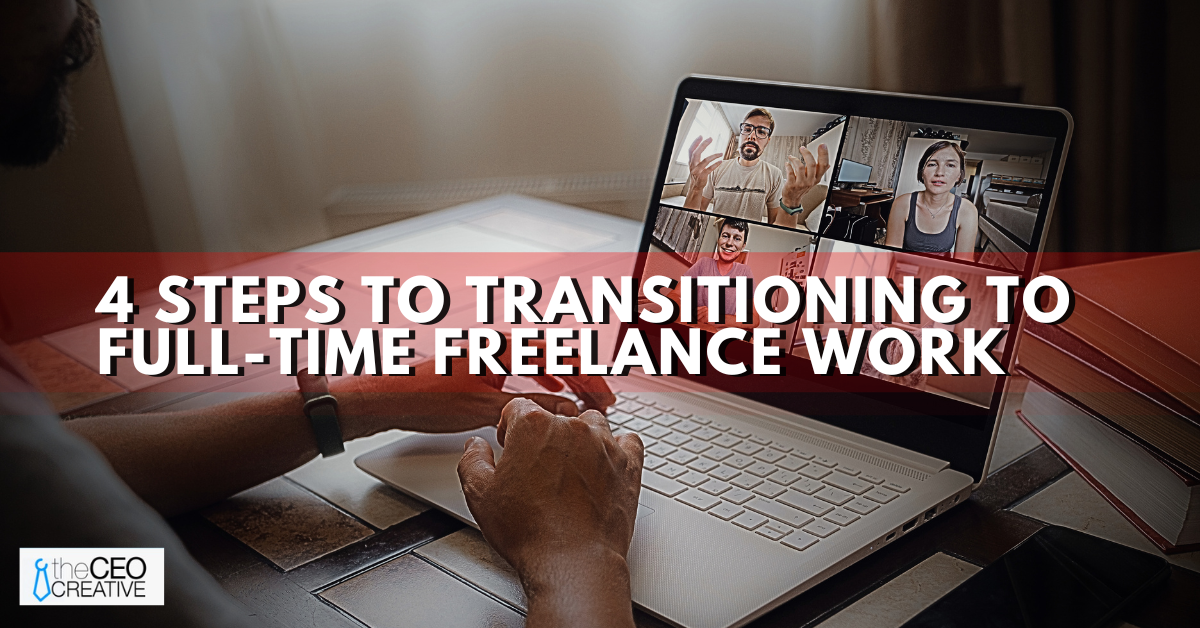Ready to dive into Full-Time Freelance Work? It’s a rollercoaster of emotions – the exhilaration of being your own boss and enjoying cozy PJ workdays, balanced with the anxiety about sustainability, finding clients, and maintaining a steady income.
The fear of the unknown looms large. How can you make this transition successfully? We’ve got you covered with 4 practical steps to navigate this exciting journey. Embrace the freedom and control of freelancing while managing the uncertainties like a pro.
Preview of the Four Essential Steps
But don’t fret just yet. The path to a successful freelance career, though unpaved, isn’t entirely unchartered. This guide will break down the four essential steps to make your transition as smooth as possible:
- Analyzing Your Skills and Market Demand
- Building a Solid Portfolio
- Setting Reasonable Rates
- Developing Strong Client Relationships
So, buckle up, and let’s embark on this journey together!
Get to know Freelance Work
Understanding what full-time freelancing actually means is the first step on the path there.
Definition and Explanation of Freelance Work
Freelancing refers to providing your professional skills or expertise to clients on a project-by-project basis, rather than being permanently employed by a single company. As a freelancer, you essentially run your own business, offering your skills and services directly to clients.
This might mean working as a graphic designer, a content writer, a digital marketer, a programmer, or any other job that can be done from just about anywhere—your home, a coffee shop, or even a beach!
The Rising Trend of Self-Employment
Fear of the unknown may be prevalent today, but the independent work style offered by freelancers is increasingly popular. More and more people are choosing to be self-employed because of the flexibility it offers.
As technology advances, virtual communication improves and global borders become less of a barrier, making freelancing a viable option. There are countless reasons for people to choose to freelance if they want to better balance work and family life by using their skills. This emerging trend is shaping the future of employment.
Benefits of Freelance Work
Embracing the world of freelance work offers a host of benefits that can’t be overlooked.
Freedom of Schedule and Choices
The major perk of turning into a full-time freelancer is the gift of flexibility. You get to manage your time, where, when, and how you work. No longer are you constrained by the 9-5 office grind. As a freelancer, you can:
- Choose the projects you are passionate about.
- Decide your own working hours.
- Work from any location you prefer.
This level of autonomy does wonders for your work-life balance and clearly, it’s a freedom that regular employment rarely offers.
Potential Challenges You Might Face
That said, freelance work isn’t all sunshine and rainbows. There are challenges you might face such as:
- Dealing with irregular income.
- Struggling to secure consistent work.
- Having to constantly market yourself.
- Balancing freelancing with other responsibilities.
Awareness of these potential struggles ahead of time can equip you with strategies to mitigate these risks. Remember, every career path has its own set of challenges – the important thing is to stay resilient and adaptable.
First Step: Evaluating Your Readiness
Venturing into full-time freelance work doesn’t mean diving head first without looking. Instead, it requires deliberate thought and self-evaluation.
Do a Self-Check if You’re Ready for the Change
Let’s be real, freelancing isn’t all sunshine and rainbows. It can be a thrilling rollercoaster with its own set of challenges. Here’s a checklist to consider if you’re ready for the change:
- Can you keep yourself accountable and meet deadlines without supervision?
- Do you have the discipline to avoid distractions and stay productive when working from home?
- Are you good at managing your finances given the unpredictable nature of freelancing income?
- Are you mentally prepared to handle the highs and lows of finding clients and periods of no work?
Understanding the Implications of a Career Transition
Transitioning into freelancing is akin to becoming a business owner. You’ll not only provide the service but also manage marketing, finance, and client relations. It requires energy, persistence, and a strong dose of self-confidence. Do your homework, understand the realm you’re stepping into, and best of luck with your decision!
Second Step: Financial Planning
Before taking the plunge into full-time freelance work, it’s essential to be savvy about financial planning. This step can’t be skipped as it provides the buffer you need to keep things afloat while you build your freelancing muscles.
Importance of Having Savings Before Transitioning
Ensuring you have savings, or somewhat of a safety net, before making the move into freelance work can give you peace of mind in times of work irregularities. The freelance market can often be unpredictable, so it’s wise to:
- Have enough cash reserves to cover at least three to six months’ worth of living expenses
- Consider a part-time job or side hustle for consistent income while starting out
- Continually replenish your savings as you earn more
Creating a Realistic Budget for Freelance Work
Formulating a realistic budget for freelance work involves more than just adding up potential earnings. Be sure to factor in the costs associated with self-employment, such as:
- Tax liabilities
- Health insurance
- Marketing and branding efforts
- Necessary tech or software
By preparing financially for your freelance career, you’re setting the groundwork for success.
Third Step: Building a Strong Portfolio
As you embark on your freelance journey, your portfolio becomes your primary calling card and key to unlocking new opportunities. It provides a showcase of your skills, creativity, and ability to deliver on assignments.
Importance of Having a Strong Portfolio
An impressive portfolio can speak volumes more than any resume. It serves as a visual testament to your capabilities and the quality of your work. It displays your versatility, creativity, and, most importantly, your unique approach. Potential clients will base much of their decision on whether to hire you on the strength of your portfolio, making this a critical aspect of your freelance journey.
Tips on How to Build an Impressive Portfolio
Building a standout portfolio doesn’t necessarily mean it needs to be bursting with content. The quality of your work always trumps quantity. Here are some tips to help you curate an impressive portfolio:
- Showcase your best work: Include projects that you’re proud of and highlight your skills.
- Be diverse: Demonstrate your versatility by including a variety of work.
- Keep updating: Regularly update your portfolio with recent projects. This shows that you’re constantly growing and evolving as a professional.
- Be concise and clear: Don’t confuse potential clients, be very clear about what you did on each project.
Fourth Step: Networking and Finding Clients
When it comes to freelancing, your client network is your lifeline. Just as in traditional employment, professional relationships hold significant weight in the freelance world.
Importance of Networking in Freelancing
Clients will not magically appear once you decide you’re ready to become a freelancer. Building a strong network is incredibly crucial. It increases your visibility and puts you in a better position to secure future gigs. And remember, it’s not just about landing clients; these connections can provide invaluable advice, resources, and support along your freelance journey. It’s about developing relationships and helping each other succeed.
Strategies to Effectively Find Potential Clients
When it comes to finding clients, there is no one-size-fits-all approach. Here are some strategies:
- Refine your pitching skills: Polish your proposals, customize them to each client, and demonstrate your value.
- Online platforms: Use freelance job platforms, social media, and networking websites to showcase your skills and attract clients.
- Word-of-mouth: Don’t forget the power of referrals. Ask satisfied clients to refer you to others.
By incorporating these strategies and maintaining consistency, you’ll be well on your path to freelancing success.
Successful Freelancer’s Experiences
Kickstarted with a bunch of insights from those who’ve tread the path, it’s time to delve into real-life trips and tricks of seasoned freelancers.
Sharing real-life experiences of successful freelancers
Many flourishing freelancers underline that their journey toward full-time freelancing was far from a walk in the park. Although the path had its fair share of challenges, they stressed that patience, perseverance, and a clear vision were critical to their success. Here are some takeaways:
- Take calculated risks and don’t be disheartened by initial failures.
- Prioritize time management and self-discipline, essential freelancing aspects that could determine your success.
- Never underestimate the value of networking and maintaining a robust professional presence, both online and offline.
Lessons learned from their experiences
One resounding lesson from veteran freelancers? Never stop learning. Be it improving your current skills, acquiring new ones, or even mastering the art of marketing yourself – learning plays an indispensable role in your freelance success story. Remember, every new project brings an opportunity to learn and grow.
Conclusion
Whether you’re a seasoned professional or a fresh graduate, moving into full-time freelance work is a big decision. It requires careful preparation and a strong commitment.
Recap of the 4 essential steps to transition to full-time freelance work
To make this career transition as seamless as possible, remember to:
- Define your niche and offer.
- Build a solid online presence.
- Focus on financial stability.
- Network and collaborate with other freelancers.
These steps are not exhaustive, but they offer a sturdy foundation upon which to build your freelance career.
Encouragement to seize the day and start freelancing.
Transitioning into freelancing is not merely a career change; it’s a lifestyle shift. It’s about finding balance, building resilience, and developing entrepreneurial grit. While the path may be challenging, remember that every journey starts with a single step. There will never be a “perfect” time to start. So, harness your energy, focus on your passion, and seize the day. The world of freelancing is waiting for you. Let’s chart your course together.











